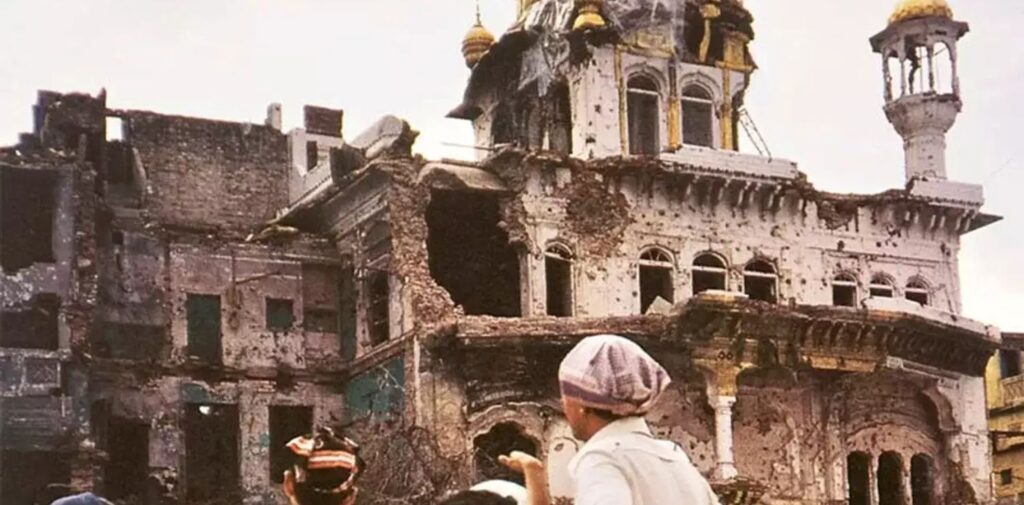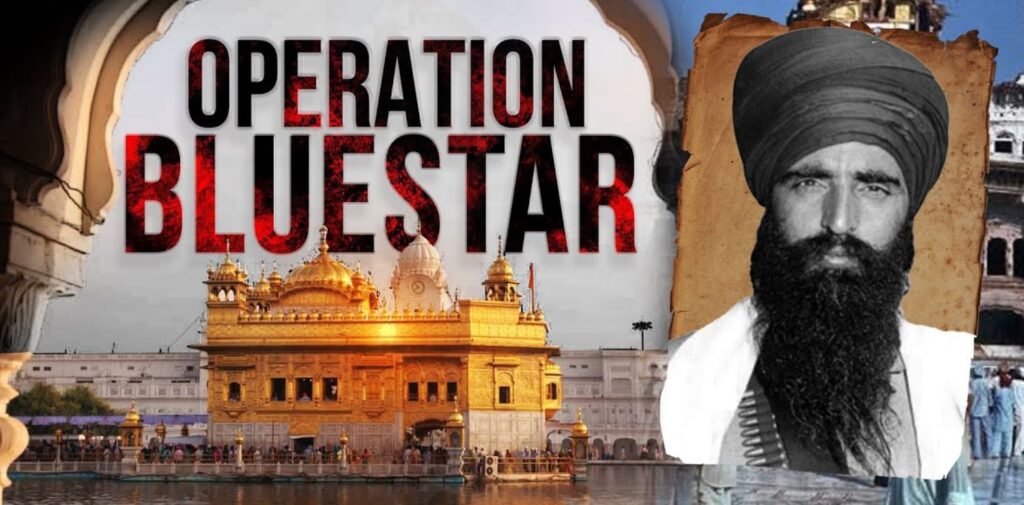Operation Blue Star stands as one of the most significant and controversial military operations in modern Indian history. Conducted by the Indian Army from June 1 to June 8, 1984, the operation aimed to remove militants who were occupying the Golden Temple, the holiest shrine of Sikhism, in Amritsar, Punjab. Led by Indian Prime Minister Indira Gandhi, the operation has been a subject of intense debate, controversy, and emotional turmoil, particularly within the Sikh community. The events surrounding the operation not only had a profound impact on India’s political landscape but also Sikh identity, leading to years of tension, violence, and a shifting sense of nationalism.
Background
The origins of Operation Blue Star can be traced to a period of intense political and social unrest in Punjab during the early 1980s. The state of Punjab, with a Sikh-majority population, was undergoing a significant political and religious upheaval. At the heart of the unrest was the demand for greater autonomy and the creation of a separate Sikh homeland called “Khalistan.”
The movement for Khalistan gained momentum under the leadership of Jarnail Singh Bhindranwale, a charismatic and controversial Sikh preacher. Bhindranwale advocated for the rights of Sikhs, emphasizing their religious identity and the need for Sikh sovereignty. He was also a vocal critic of the Indian government’s treatment of Sikhs and what he perceived as a marginalization of the community. As his influence grew, Bhindranwale became more militant, using the Golden Temple complex as a base for his operations. This led to significant tension between Bhindranwale and the Indian government.
By 1983, Bhindranwale and his armed followers had fortified themselves inside the Golden Temple complex. They began to challenge the Indian state’s authority, and several confrontations between Bhindranwale’s group and government forces ensued. The Indian government, under Prime Minister Indira Gandhi, was under increasing pressure to deal with the situation.

The Build-Up to Operation Blue Star
The Sikh militants in the Golden Temple complex were heavily armed, and by the spring of 1984, the Indian government had decided to take decisive action. The Golden Temple, a symbol of Sikh religious and cultural identity, had become a fortress for Bhindranwale and his followers. The government feared that if left unchecked, the movement for Khalistan would spread beyond Punjab and could destabilize the entire country. For Indira Gandhi, the operation was seen as a necessary step to restore law and order in Punjab and assert the authority of the Indian state.
However, the situation was complicated by the sacredness of the Golden Temple. The Akal Takht, located within the temple complex, was the highest temporal seat of the Sikhs, and the Golden Temple itself was a revered place of worship. Any military action taken within the complex would risk desecrating the holiest site in Sikhism, which was a sensitive issue for millions of Sikhs around the world.
Indira Gandhi’s decision to proceed with the operation was controversial. She and her advisors had hoped to avoid a full-scale assault, and initial negotiations with the militants had failed. The government, under pressure from various quarters, including the Indian military and political establishment, finally approved the use of force to resolve the crisis.

The Execution of Operation Blue Star
On June 1, 1984, the Indian Army launched Operation Blue Star. The operation was led by General Kuldip Singh Brar, who commanded the Eastern Command. The plan involved a two-pronged approach: an initial siege of the Golden Temple complex to isolate the militants and prevent their escape, followed by a series of coordinated attacks to eliminate the armed militants.
The Army deployed a large number of troops, including elite special forces, and began surrounding the Golden Temple complex. The initial stages of the operation involved tank and artillery fire, along with aerial bombardments to weaken the militants’ positions. The military faced stiff resistance from Bhindranwale’s forces, who had fortified themselves within the complex. The fighting escalated over the next several days, with heavy casualties on both sides.
The Indian Army’s assault on the Golden Temple was harsh and precise, but it was not without its challenges. Bhindranwale and his followers fought back fiercely, using the temple’s many rooms, corridors, and secret passageways to their advantage. The situation was made even more complicated by the presence of civilians, including devotees who had come to the Golden Temple during the Sikh religious observance, which coincided with the operation.
The fighting continued through June 3 and 4, and by June 5, the military had gained control of the main areas of the Golden Temple complex. Bhindranwale was killed in the fighting, along with many of his followers. However, the Army had taken significant damage to the structure, and several parts of the temple, including the Akal Takht, were heavily damaged by artillery fire.
The operation officially ended on June 8, but it had already caused widespread devastation. Estimates of the casualties vary, but it is believed that several hundred people, including militants, soldiers, and civilians, were killed during the operation.
The Aftermath of Operation Blue Star
The immediate aftermath of Operation Blue Star was marked by a wave of anger and grief, particularly among Sikhs. The desecration of the Golden Temple and the deaths of many innocent people created a deep sense of betrayal and outrage within the Sikh community. Many Sikhs viewed the attack as an assault not only on their religious identity but also on their very existence as a people.
In the wake of the operation, the Indian government faced widespread protests, violence, and unrest in Punjab and other parts of India. The operation intensified calls for Khalistan, and Bhindranwale, who had been killed in the operation, was elevated to the status of a martyr in the eyes of many Sikhs. The sense of alienation and anger among Sikhs grew, leading to a period of prolonged violence in Punjab, including targeted killings, bombings, and the rise of militant factions calling for Khalistan.
One of the most tragic events that followed Operation Blue Star was the assassination of Prime Minister Indira Gandhi on October 31, 1984, by her Sikh bodyguards in retaliation for the operation. This assassination sparked violent anti-Sikh riots across India, particularly in Delhi, where thousands of Sikhs were killed, their homes and businesses destroyed, and their properties looted. The violence, which continued for several days, led to widespread condemnation and calls for justice, although many felt that the perpetrators were not held accountable.

Long-Term Consequences
Operation Blue Star had far-reaching consequences for both India and the Sikh community. In Punjab, the operation marked the beginning of a prolonged period of violence and instability. The Sikh militancy that had been sparked by the events of 1984 continued for several years, with the Indian government fighting an insurgency in the region. While the Indian Army succeeded in suppressing the militant movement, the operation’s legacy continued to haunt the relationship between Sikhs and the Indian state.
For Sikhs worldwide, Operation Blue Star became a symbol of state oppression, and the events of 1984 have been deeply ingrained in the collective memory of the Sikh diaspora. The operation and its aftermath led to increased calls for Sikh rights and greater recognition of the community’s grievances.
Politically, Operation Blue Star further polarized India, dividing opinions on how the Indian state should have dealt with the situation. Some supported the operation, believing it was necessary to restore law and order, while others criticized it for being an excessive use of force in a sacred place.
Conclusion
Operation Blue Star remains one of the most contentious chapters in the history of post-independence India. The events surrounding the operation, the loss of life, and the impact on the Sikh community have left deep scars that are still felt today. The complex interplay of religion, politics, and national security during the operation continues to fuel debates about the relationship between India and its Sikh citizens, as well as the legacy of Indira Gandhi’s decision to use military force in such a sensitive and sacred location.




